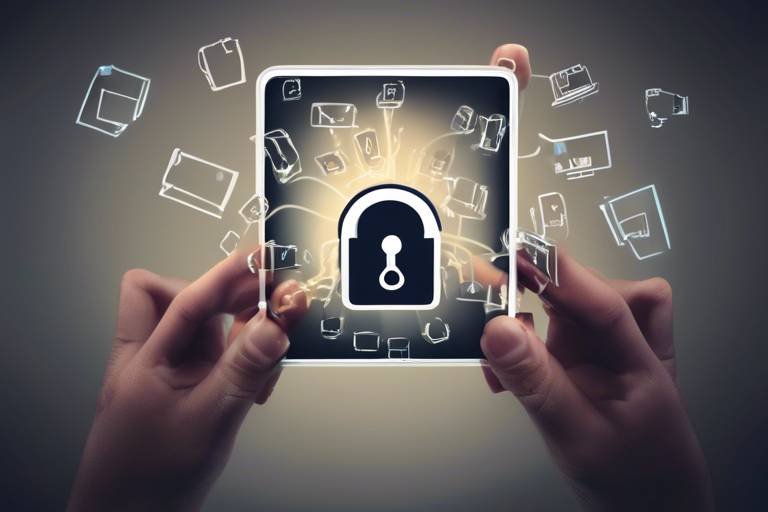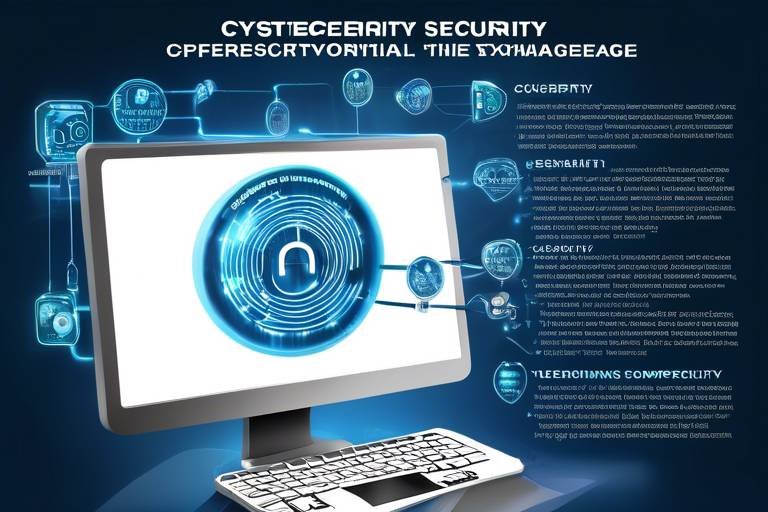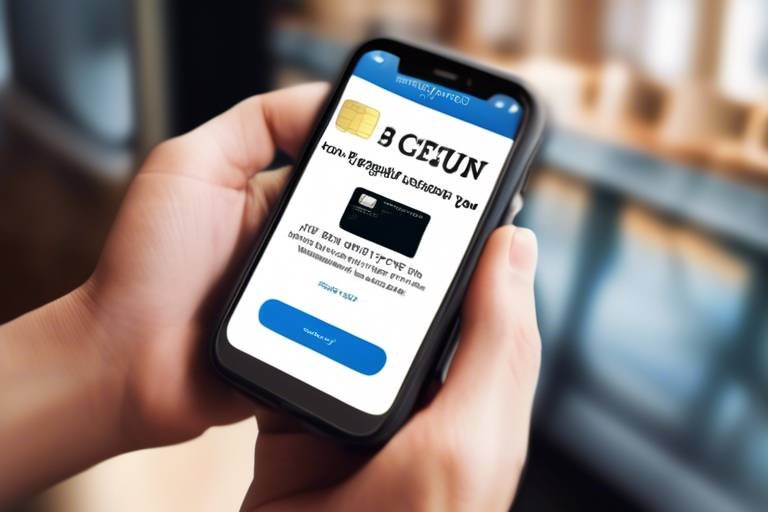How to Secure Your Digital Life in 10 Steps
In today’s hyper-connected world, securing your digital life is not just a luxury; it’s a necessity. With cyber threats lurking around every corner, from identity theft to malware attacks, the importance of protecting your personal information cannot be overstated. But don’t worry! This article outlines essential strategies to enhance your online security, protect your personal information, and safeguard against cyber threats. By following these steps, you can create a safer digital environment for yourself and enjoy peace of mind while navigating the online landscape.
To secure your digital life, it's crucial to understand the various types of cyber threats that exist. Cyber threats are like the unseen monsters hiding in the shadows of the internet, waiting for the perfect moment to strike. Some of the most common threats include:
- Malware: This includes viruses, worms, and ransomware designed to damage or disable computers and networks.
- Phishing: A deceptive tactic where attackers impersonate legitimate entities to steal sensitive information.
- Identity Theft: When someone uses your personal information without your consent, often for financial gain.
Awareness is the first step to effective protection. By understanding these threats, you can better prepare yourself to combat them. Think of it as learning the rules of a game before you start playing; knowledge is power!
Strong passwords are your first line of defense against unauthorized access. A weak password is like leaving your front door wide open for intruders. To create complex and unique passwords, consider the following tips:
- Use a mix of uppercase and lowercase letters, numbers, and special characters.
- Avoid using easily guessable information, such as birthdays or names of pets.
- Consider using phrases or sentences that are easy for you to remember but hard for others to guess.
By implementing these strategies, you significantly reduce the risk of unauthorized access to your accounts. Remember, a strong password is like a sturdy lock on your digital door.
Password managers are invaluable tools that can help you generate and store secure passwords. Imagine having a personal vault that holds all your passwords securely while you only need to remember one master password. These tools not only simplify your online security efforts but also enhance them by ensuring that you use unique passwords for every account. It’s like having a digital bodyguard that keeps your sensitive information safe!
Not all password managers are created equal. When selecting a password manager, look for key features such as:
- Encryption methods to protect your data.
- Cross-platform compatibility for access on various devices.
- Ease of use and user-friendly interface.
Choosing the right password manager is crucial for maintaining your online security. It’s like picking the right tool for a job; the right choice makes all the difference!
Two-factor authentication (2FA) adds an extra layer of security to your accounts. It’s like having a second lock on your door. Even if someone manages to get your password, they won’t be able to access your account without the second factor, typically a code sent to your phone. Discover how to enable this feature on your accounts and the additional protection it offers against unauthorized access. Trust me, it’s worth the extra few seconds to set it up!
Phishing scams are prevalent and can compromise your information if you’re not careful. These scams often come disguised as legitimate emails or messages, tricking you into giving away personal information. To avoid falling victim, learn how to identify phishing attempts:
- Look for poor grammar and spelling errors.
- Be cautious of urgent messages that create a sense of panic.
- Always verify the sender’s email address.
By staying vigilant and recognizing these deceptive tactics, you can protect yourself from becoming a victim of cybercrime.
Your devices are gateways to your personal information, and securing them is paramount. This section covers essential practices for safeguarding smartphones, tablets, and computers against unauthorized access and malware. Think of your devices as your digital home; just like you wouldn’t leave your home unguarded, you shouldn’t leave your devices vulnerable either.
Regular software updates are crucial for maintaining security. Software developers frequently release updates to patch vulnerabilities that could be exploited by cybercriminals. Ignoring these updates is like leaving a window open in a storm; you’re inviting trouble. Understand the importance of keeping your operating systems and applications up to date to protect against vulnerabilities.
Antivirus software plays a key role in defending against malware. It acts as a shield, scanning for and eliminating threats before they can do any damage. Explore the options available and how to choose the best antivirus solution for your devices. Remember, just like you wouldn’t skip a routine check-up for your car, you shouldn’t neglect your device’s security.
Q: How often should I change my passwords?
A: It’s recommended to change your passwords every 3 to 6 months, or immediately if you suspect a breach.
Q: Is it safe to use public Wi-Fi?
A: Public Wi-Fi can be risky. Always use a VPN for added security when accessing sensitive information.
Q: What should I do if I think I’ve been a victim of identity theft?
A: Immediately report the theft to your bank, credit card companies, and the authorities. Consider placing a fraud alert on your credit report.

Understanding Cyber Threats
In today’s digital landscape, the internet is a double-edged sword. While it offers endless opportunities for connection and information, it also opens the door to a myriad of cyber threats that can compromise your personal information and security. Understanding these threats is not just beneficial; it’s essential for anyone navigating the online world. So, what are these threats, and how can they affect you?
First off, let’s talk about malware. This term encompasses various types of malicious software designed to infiltrate your devices without your consent. From viruses that corrupt your files to ransomware that locks you out of your own data, malware can wreak havoc on your digital life. Think of it as a sneaky burglar that finds a way into your home, rummages through your belongings, and leaves chaos in its wake.
Another significant threat is phishing. This deceptive tactic involves tricking individuals into providing sensitive information, such as passwords or credit card numbers, often through seemingly legitimate emails or websites. Imagine receiving an email from what looks like your bank, asking you to verify your account. If you’re not careful, you might just hand over your information to a cybercriminal. Recognizing these scams is crucial, as they can lead to identity theft and financial loss.
Speaking of identity theft, this is yet another growing concern. It occurs when someone steals your personal information—like your Social Security number or bank details—and uses it without your permission. This can lead to fraudulent transactions and a long, arduous process to reclaim your identity. It’s like someone wearing your clothes and pretending to be you; it can be incredibly damaging both financially and emotionally.
To better understand these threats, here’s a quick overview of the most common types:
- Malware: Includes viruses, worms, trojans, and ransomware.
- Phishing: Deceptive emails and websites aimed at stealing personal information.
- Identity Theft: The unauthorized use of someone’s personal information.
- Denial-of-Service Attacks: Overloading a system to make it unavailable to users.
By familiarizing yourself with these threats, you can take proactive steps to protect your digital life. Awareness is the first line of defense. Just as you wouldn’t leave your front door wide open in a busy neighborhood, you shouldn’t leave your online accounts vulnerable. Knowledge empowers you to recognize potential dangers and respond appropriately.
In conclusion, understanding cyber threats is a vital part of safeguarding your digital life. By staying informed about the various types of threats, you can better prepare yourself to defend against them. Remember, the internet is a vast place filled with both wonders and risks. Equip yourself with knowledge, and you can navigate it safely.

Creating Strong Passwords
In today's digital world, creating strong passwords is more important than ever. Think of your password as the key to your digital house; if it's weak, anyone can waltz right in and rummage through your personal belongings. So, how do you craft a password that stands up to the test of time and cybercriminals? First off, it’s essential to understand that a strong password should be at least 12 to 16 characters long and include a mix of uppercase letters, lowercase letters, numbers, and special characters. This combination makes it significantly harder for hackers to crack your password using brute force methods.
Moreover, avoid using easily guessable information such as your name, birthdate, or common words. Instead, consider using a passphrase—a series of random words or a sentence that you can easily remember but others wouldn’t guess. For example, “BlueSky!Dance&2023” is much more secure than “password123.” You can also get creative by substituting numbers or symbols for letters, like using “@” for “a” or “3” for “e.”
Another important tip is to never reuse passwords across different accounts. Imagine if a hacker gets access to one of your accounts; they could potentially access all your other accounts using the same password. To keep your accounts secure, each one should have a unique password. This is where a password manager can come in handy. These tools can generate complex passwords for you and store them securely, so you don’t have to remember every single one. Just remember to choose a strong master password for your password manager!
Speaking of password managers, they are a game-changer in the realm of online security. Not only do they help you create and store strong passwords, but they also save you the hassle of trying to remember them all. Most password managers can automatically fill in your passwords on websites, making logging in a breeze. But with so many options available, how do you choose the right one? Look for features like encryption, multi-device support, and user-friendly interfaces. This way, you can ensure that your passwords are safe and accessible whenever you need them.
When selecting a password manager, consider the following features:
| Feature | Importance |
|---|---|
| Encryption | Ensures your data is secure from unauthorized access. |
| Multi-device support | Allows you to access your passwords on various devices seamlessly. |
| User-friendly interface | Makes it easy for you to manage your passwords without a steep learning curve. |
By choosing a password manager that includes these features, you can significantly enhance your online security while simplifying your digital life.
In addition to creating strong passwords, consider enabling two-factor authentication (2FA) on your accounts. This adds an extra layer of security by requiring not only your password but also a second form of verification, such as a text message code or an authentication app. It’s like having a double lock on your door; even if someone manages to guess your password, they still can’t get in without that second piece of information. Many platforms now offer 2FA as a standard security feature, so take the time to set it up and keep those cybercriminals at bay!
Finally, while strong passwords and 2FA are crucial, they won’t do much good if you fall for phishing scams. Always be on the lookout for suspicious emails or messages that ask for your personal information. If something feels off, trust your instincts and verify the source before clicking on any links or providing any information.

Using Password Managers
In our fast-paced digital world, keeping track of multiple passwords can feel like trying to juggle flaming torches—one slip, and you could get burned! This is where password managers come into play, acting like your personal assistant for all things password-related. Think of them as a secure vault, where you can store all your complex and unique passwords without the fear of forgetting them. Instead of recycling the same weak password across different sites (which is like leaving your front door wide open), a password manager allows you to create strong, unique passwords for each of your accounts, significantly reducing the risk of unauthorized access.
So, how does a password manager work? Essentially, it generates and encrypts your passwords, storing them in a secure environment that only you can access. When you need to log into a site, the password manager fills in your credentials automatically, saving you time and the headache of remembering each one. But not all password managers are created equal. When choosing one, look for features that suit your needs, such as:
- Encryption Standards: Ensure it uses strong encryption to protect your data.
- Cross-Platform Compatibility: Choose one that works on all your devices—PCs, smartphones, and tablets.
- Two-Factor Authentication: Look for a manager that offers this extra layer of security.
Let’s not forget the convenience factor. Imagine walking into a bookstore and finding a treasure trove of books you’ve been meaning to read. That’s what using a password manager feels like—everything you need is right at your fingertips, neatly organized and ready to go. Plus, many password managers can also help you identify weak passwords and suggest stronger alternatives, making your digital life even more secure.
However, it’s essential to choose a reputable password manager. There are plenty of options out there, but some may not prioritize your security as much as others. Before making a decision, do thorough research. Look for reviews, check out their security features, and see if they have a history of data breaches. Your digital safety is worth the extra effort!
In conclusion, using a password manager is a smart step towards securing your online presence. It’s like having a digital fortress that keeps your sensitive information safe while allowing you to navigate the online world with ease. So, why not take the plunge? Start exploring password managers today and give your digital life the protection it deserves!

Choosing the Right Password Manager
When it comes to securing your digital life, selecting the right password manager is like choosing the right lock for your front door. With so many options available, it can feel overwhelming to find the one that best fits your needs. A good password manager not only stores your passwords securely but also helps you generate strong, unique passwords for every account you have. This is crucial because using the same password across multiple sites is like using a single key for every door in your house—if one gets compromised, they all do!
First and foremost, consider the security features offered by different password managers. Look for those that provide end-to-end encryption, ensuring that only you can access your passwords. Additionally, some password managers offer features like biometric login options (fingerprint or facial recognition), which add an extra layer of protection. Think of this as having a high-tech security system that only you can operate.
Another aspect to consider is cross-platform compatibility. You want a password manager that works seamlessly across all your devices—whether you’re on your laptop, smartphone, or tablet. Imagine trying to access your passwords on a device that isn’t supported; it’s like trying to open a door with the wrong key. A good password manager should sync your data across devices, making it easy to access your information whenever you need it.
Cost is also a factor to keep in mind. While there are many free options available, they often come with limitations. Paid password managers typically offer more robust features and better customer support. It’s worth investing a little money for peace of mind, akin to paying for a high-quality lock instead of a flimsy one. To give you a clearer picture, here's a quick comparison table of some popular password managers:
| Password Manager | Price | Key Features |
|---|---|---|
| LastPass | Free / Premium $3/month | Cross-platform, password sharing, dark web monitoring |
| 1Password | $2.99/month | Travel mode, secure document storage, family sharing |
| Dashlane | Free / Premium $4.99/month | VPN service, dark web monitoring, password health reports |
Lastly, user experience is vital. A password manager should have a user-friendly interface that makes it easy to navigate and manage your passwords. If it feels complicated or cumbersome, you might find yourself avoiding it altogether, which defeats the purpose. Look for one that offers a smooth onboarding process and helpful tutorials, so you can get started without feeling overwhelmed.
In summary, choosing the right password manager is about balancing security, functionality, cost, and user experience. Take your time to research and even try out a few options before committing. After all, this is your digital fortress we’re talking about—it deserves the best protection!
- What is a password manager? A password manager is a tool that stores and manages your passwords securely, allowing you to use complex and unique passwords for different accounts.
- Are password managers safe? Yes, when you choose a reputable password manager that uses strong encryption, your passwords are kept secure.
- Can I use a password manager on my phone? Absolutely! Most password managers are available on multiple platforms, including mobile devices.

Setting Up Two-Factor Authentication
Setting up Two-Factor Authentication (2FA) is one of the most effective ways to enhance your online security. Think of it like adding a second lock to your front door; even if someone has your key (your password), they still can’t get in without that second lock. This extra layer of security requires not just your password but also a second piece of information that only you possess. This could be a code sent to your phone, a fingerprint, or even a physical security key.
To get started with 2FA, follow these simple steps:
- Choose Your Accounts Wisely: Not all accounts require 2FA, but you should prioritize securing your most sensitive accounts, such as email, banking, and social media.
- Access Security Settings: Log in to your account and navigate to the security settings. Look for options labeled as “Two-Factor Authentication,” “2-Step Verification,” or similar terms.
- Select Your Method: Most services offer several options for 2FA. You can choose to receive a text message, use an authentication app, or even get a hardware token. Each method has its pros and cons, so pick the one that feels right for you.
- Follow the Prompts: Once you select your method, follow the on-screen instructions. This usually involves entering a code sent to your phone or generated by an app.
- Backup Codes: Many services provide backup codes during the setup process. Store these codes in a safe place, as they can help you regain access if you lose your phone or can’t receive codes.
Enabling 2FA significantly reduces the chances of unauthorized access. Even if a hacker manages to obtain your password, they won't have access to the second factor needed to log in. It's like a double-check system that keeps your digital life secure.
In addition to enhancing security, using 2FA can also give you peace of mind. Imagine you’re on vacation, and you hear about a data breach affecting your favorite service. With 2FA in place, you can rest assured that your account is still safe, even if your password is compromised.
However, it’s essential to remember that while 2FA adds a substantial layer of security, it’s not foolproof. Always stay vigilant and keep your personal information secure. Regularly review your security settings and update your passwords, even if you have 2FA enabled. Cyber threats are constantly evolving, and staying one step ahead is crucial.
In conclusion, setting up Two-Factor Authentication is a straightforward yet powerful way to secure your online accounts. By taking a few minutes to implement this feature, you're investing in your digital safety. So, why wait? Take action today and fortify your online presence!
Here are some common questions people have about Two-Factor Authentication:
- What is Two-Factor Authentication? - It’s a security process that requires two different forms of identification before accessing an account.
- Is 2FA necessary? - While not mandatory, it greatly enhances security and is recommended for sensitive accounts.
- Can I use 2FA on all my accounts? - Most major online services offer 2FA, but check your account settings to confirm.
- What if I lose my phone? - Use the backup codes provided during setup or contact customer support for help regaining access.

Recognizing Phishing Attempts
In today's digital landscape, phishing attempts are more prevalent than ever, and they can strike at any moment, often disguised as legitimate communications. Imagine receiving an email that looks like it’s from your bank, urging you to click a link to verify your account. It’s alarming how easily one can be tricked into providing sensitive information, isn't it? The key to avoiding these traps lies in your ability to recognize the signs of phishing.
Phishing scams typically come in the form of emails, text messages, or even phone calls that appear to be from trusted sources. They aim to steal your personal information, such as passwords, credit card numbers, or Social Security numbers. To help you stay vigilant, here are some common characteristics of phishing attempts:
- Generic Greetings: Phishing emails often use vague salutations like "Dear Customer" instead of your name. Legitimate companies usually personalize their communication.
- Urgent Requests: Many phishing attempts create a sense of urgency, claiming that immediate action is required to prevent account suspension or unauthorized access.
- Suspicious Links: Hover over any links before clicking. If the URL looks strange or doesn't match the official website, it's a red flag.
- Attachments: Be cautious of unexpected attachments. They could contain malware designed to infiltrate your device.
- Poor Grammar and Spelling: Many phishing emails are riddled with typos and grammatical errors, which can be a sign that they're not from a reputable source.
Recognizing these signs can significantly reduce your risk of falling victim to a phishing scam. But what should you do if you suspect you've received a phishing email? First, do not click on any links or download attachments. Instead, report the email to your IT department or the relevant institution. You can also forward the email to the Federal Trade Commission (FTC) at spam@uce.gov to help combat these scams.
In addition, consider using tools and software that provide phishing protection. Many email services now include built-in filters that can catch potential phishing attempts before they reach your inbox. However, relying solely on technology isn't enough. Staying informed and aware of the latest phishing tactics is crucial in this ever-evolving digital threat landscape.
In summary, recognizing phishing attempts is all about being observant and skeptical of unsolicited communications. By familiarizing yourself with the common traits of phishing scams and taking proactive measures, you can safeguard your personal information and maintain a secure online presence.
Q: What should I do if I accidentally clicked on a phishing link?
A: If you clicked on a phishing link, immediately disconnect from the internet and run a security scan on your device. Change your passwords for any accounts that may have been compromised, and monitor your financial statements for any unusual activity.
Q: Can phishing attempts occur via social media?
A: Yes, phishing attempts can happen on social media platforms as well. Be cautious of messages from unknown users or suspicious links shared in posts.
Q: How can I report phishing attempts?
You can report phishing emails to the FTC at spam@uce.gov, and if it’s a specific company, forward the email to their official support email.

Securing Your Devices
In today's digital world, your devices serve as gateways to a treasure trove of personal information. Whether it's your smartphone, tablet, or computer, each device is a potential target for cybercriminals. To keep your digital life secure, it’s essential to adopt a proactive approach to device security. Think of your devices as your home; you wouldn't leave the front door wide open, would you? Just as you lock your doors and windows, securing your devices is crucial to safeguarding your personal data.
First and foremost, always use a passcode or biometric lock on your devices. This simple step can deter unauthorized access and protect your information from prying eyes. Imagine if someone could just walk into your house without any barriers; the same vulnerability exists with unlocked devices. By requiring a passcode or fingerprint, you create a barrier that keeps your information safe.
Next, let's talk about the importance of updating your software regularly. Software updates often include critical security patches that protect against newly discovered vulnerabilities. Failing to update can leave your devices exposed to threats. It’s like having a security system that you never upgrade; over time, it becomes less effective. So, make it a habit to check for updates frequently. Most devices allow you to enable automatic updates, which can save you the hassle of remembering to do it manually.
Another essential aspect of securing your devices is the use of antivirus software. Think of antivirus software as a security guard for your digital life. It actively scans for malware and other threats, providing peace of mind. With numerous options available, it’s important to choose a solution that fits your needs. Look for features such as real-time scanning, automatic updates, and a user-friendly interface. You wouldn’t hire a security guard who doesn’t know how to protect your property, right? The same logic applies here.
Moreover, consider the network you connect to. Public Wi-Fi networks are notoriously insecure, making it easy for hackers to intercept your data. If you must use public Wi-Fi, always connect through a Virtual Private Network (VPN). A VPN encrypts your internet connection, making it much harder for anyone to snoop on your activities. It’s like having a secure tunnel that protects your data from prying eyes.
Lastly, don't underestimate the importance of being vigilant. Always be cautious about the apps you download and the permissions you grant. Some apps may request access to more information than necessary. Before hitting "install," ask yourself: Is this app worth the risk? Review permissions and only download apps from reputable sources. This can significantly reduce the chance of inadvertently installing malicious software.
| Device Type | Security Measure | Importance |
|---|---|---|
| Smartphone | Passcode/Biometric Lock | Prevents unauthorized access |
| Tablet | Regular Software Updates | Protects against vulnerabilities |
| Computer | Antivirus Software | Defends against malware |
| All Devices | VPN for Public Wi-Fi | Encrypts internet connection |
By following these steps and remaining vigilant, you can significantly enhance the security of your devices. Remember, securing your digital life is an ongoing process, not a one-time task. Stay informed about the latest threats and continue to adapt your security measures accordingly. After all, in the ever-evolving landscape of cyber threats, knowledge is your best defense.
- What is the most effective way to secure my device? Regularly update your software, use strong passwords, and install antivirus software.
- Is public Wi-Fi safe to use? Public Wi-Fi can be risky; always use a VPN to protect your data.
- How often should I update my antivirus software? Ideally, keep it set to update automatically, but check for manual updates at least once a month.

Updating Software Regularly
In the fast-paced digital world we live in, is not just a good habit; it's a crucial step in protecting your online presence. Think of your software as the walls of your digital home. Just like you wouldn't leave your home with crumbling walls and broken locks, you shouldn't ignore the updates that keep your devices secure. Each update is like a fresh coat of paint, sealing off vulnerabilities that hackers could exploit.
When software developers discover security flaws, they often release updates to patch these vulnerabilities. If you neglect to update your software, you're essentially leaving the door wide open for cybercriminals. According to cybersecurity experts, a significant percentage of successful cyber attacks are due to outdated software. So, how do you ensure you’re staying on top of your updates?
First, enable automatic updates whenever possible. This way, your devices will download and install updates without you having to lift a finger. It's like having a security system that works while you sleep! However, you should also make it a habit to check for updates manually, especially for critical software like your operating system and antivirus programs. Regular checks act as a safety net, catching any updates that may have slipped through.
Here's a quick breakdown of the types of software you should prioritize for updates:
- Operating Systems: Windows, macOS, Linux
- Applications: Browsers, office suites, media players
- Security Software: Antivirus, firewalls, VPNs
- Device Firmware: Routers, IoT devices
Now, let’s talk about the benefits of keeping your software updated:
| Benefit | Description |
|---|---|
| Enhanced Security | Updates often include patches for security vulnerabilities, protecting you from potential threats. |
| Improved Performance | Many updates come with bug fixes and performance enhancements, making your software run smoother. |
| New Features | Updates can introduce new functionalities and improvements that enhance user experience. |
In conclusion, treating software updates as a priority rather than a chore can significantly bolster your digital security. It’s like giving your devices a regular health check-up, ensuring they’re fit to fend off any potential threats. Remember, the digital landscape is ever-evolving, and so are the tactics of cybercriminals. Stay ahead of them by making software updates a non-negotiable part of your online safety routine.
Q: How often should I update my software?
A: Ideally, you should check for updates at least once a week. Enable automatic updates for convenience.
Q: What if I forget to update my software?
A: Set reminders on your calendar or use tools that notify you when updates are available.
Q: Are all updates important?
A: While not every update adds new features, security updates are crucial. Always prioritize them.
Q: Can I skip updates?
A: While you can technically skip updates, doing so may expose your devices to security risks. It's best to stay updated.

Using Antivirus Software
In today's digital landscape, where cyber threats lurk around every corner, using antivirus software is not just a recommendation—it's a necessity. Think of antivirus software as your digital bodyguard, tirelessly working to protect your sensitive information from malicious attacks, viruses, and malware. But how do you choose the right one? And once you have it, how do you make sure it’s doing its job effectively?
First and foremost, it's essential to understand what antivirus software does. Essentially, it scans your computer or device for harmful software, removes it, and helps prevent future infections. However, not all antivirus solutions are created equal. Some are robust and offer comprehensive protection, while others may only provide basic coverage. To help you navigate this sea of options, here are some key features you should look for when selecting antivirus software:
- Real-time Protection: This feature actively scans files and applications as they are opened to prevent threats before they can cause damage.
- Malware Removal: Ensure the software can effectively detect and remove various types of malware, including viruses, worms, and trojans.
- Regular Updates: Cyber threats evolve rapidly, so your antivirus software must receive regular updates to stay ahead of new threats.
- Firewall Protection: A built-in firewall can provide an additional layer of security by monitoring incoming and outgoing network traffic.
- User-Friendly Interface: A simple, intuitive interface can make managing your security settings much easier.
Choosing the right antivirus software is like picking the best tool for a job; you want something that not only gets the job done but also fits your specific needs. For example, if you frequently download files or visit less reputable websites, you might want a solution with more aggressive scanning capabilities. Conversely, if you're a casual user who primarily browses social media and checks emails, a basic version may suffice.
Once you’ve selected your antivirus software, the next step is installation and configuration. Follow the on-screen instructions carefully, and don’t skip any steps, especially those related to enabling real-time protection. After installation, it’s a good idea to run a full system scan. This initial scan will help identify any existing threats that may have already infiltrated your device.
After your antivirus is up and running, remember that it requires ongoing maintenance. Regularly scheduled scans are crucial for ensuring your system remains clean and secure. Most antivirus programs allow you to set up automatic scans, which can save you time and ensure you don’t forget to check for threats. Additionally, keep an eye out for any alerts or notifications from your antivirus software, as these can provide valuable insights into potential threats or necessary actions.
In conclusion, using antivirus software is a fundamental step in securing your digital life. It's like having a safety net that catches you before you fall into the abyss of cyber threats. By choosing the right software, configuring it correctly, and maintaining it regularly, you can significantly reduce your risk of falling victim to cybercrime. Remember, in the world of cybersecurity, vigilance is key!
Q: How often should I update my antivirus software?
A: It's best to enable automatic updates for your antivirus software to ensure you always have the latest protection against new threats.
Q: Can I use free antivirus software?
A: Yes, free antivirus software can provide basic protection, but it may lack advanced features found in paid versions. Assess your needs before deciding.
Q: What should I do if my antivirus software detects a threat?
A: Follow the software's instructions to quarantine or remove the threat. Running a full system scan afterward is also advisable to ensure no remnants remain.
Frequently Asked Questions
- What are the most common types of cyber threats?
Cyber threats come in various forms, but some of the most common include malware, which is malicious software designed to harm your devices; phishing, where attackers trick you into providing personal information; and identity theft, where someone impersonates you to commit fraud. Understanding these threats is the first step in protecting yourself.
- How can I create a strong password?
A strong password should be a mix of uppercase and lowercase letters, numbers, and special characters. Aim for at least 12 characters and avoid using easily guessable information like birthdays or names. Think of your password as a fortress—strong walls keep intruders out!
- What is a password manager and why should I use one?
A password manager is a tool that helps you generate and store complex passwords securely. It’s like having a safe for your passwords, so you don’t have to remember every single one. By using a password manager, you can create unique passwords for each of your accounts without the hassle of memorizing them.
- How do I enable two-factor authentication?
To enable two-factor authentication (2FA), go to the security settings of your account. Look for the option that says Enable Two-Factor Authentication or something similar. You’ll typically need to provide a phone number or use an authentication app to receive a verification code. This adds an extra layer of security, making it much harder for anyone to access your account without your permission.
- What should I do if I receive a suspicious email?
If you receive a suspicious email, don’t click on any links or download attachments. Instead, check the sender's email address for any signs of forgery and look for spelling errors or unusual requests. If it seems fishy, it's better to delete it or report it as spam. Trust your instincts—if it feels off, it probably is!
- How often should I update my software?
It’s best to update your software as soon as updates are available. Most software companies release updates regularly to patch vulnerabilities and improve security. Think of updates as a shield against cyber threats—delaying them can leave you exposed!
- Do I really need antivirus software?
Yes, antivirus software is essential for protecting your devices from malware and other threats. It acts like a security guard, monitoring your system for suspicious activity and blocking harmful software. Without it, you’re leaving your digital doors wide open!



















